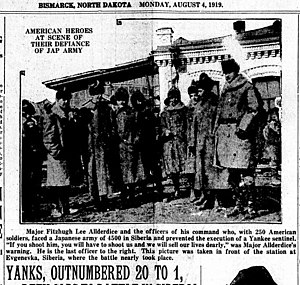Incident
An American unit of the 27th Infantry Regiment was based at Evgenevka, Station on the Trans-Siberian Railway. An American sentry, known as Private "Little" Smith, was guarding a portion of the station when a Japanese unit was disembarking from the train. One of the Japanese soldiers tried to pass into the American section but was blocked by Smith. The Japanese soldier, angered by Smith's refusal, smacked the American across the head with his canteen strap. In response, Smith raised his gun to fire but his rifle jammed and so he stabbed the Japanese soldier in the neck with his bayonet.
After their soldier was wounded the Japanese unit seized Smith and threatened to execute him. Alerted by American soldiers, the commander of the American 27th Infantry Regiment, Major Fitzhugh Lee Allderdice, mobilized all 250 men under his command and marched to the station to free Smith. When they arrived at the station, a Japanese captain tried to stab an American but the blow was blocked by his heavy sheepskin jacket. Major T. Airi, the commander of the Japanese, then arrived and started negotiating with Allderdice. When the Japanese captain became enraged, he lunged at the Americans again but Major Airi blocked the blow with his body, receiving a wound on his shoulder. The Americans drew their guns and Allderdice spoke through the translator stating that, "Very well, if you shoot an American soldier tonight you'll have to annihilate my command. You know what that means - we - are outnumbered 20 to 1, but we'll sell our lives dearly." When the Japanese captain still refused to listen and raised his sword, Allderdice stated, "If you want war with the United States you'll get it if you raise your hand against this command."
Smith was eventually freed after it was agreed that the Americans would salute the Japanese officers in the station.
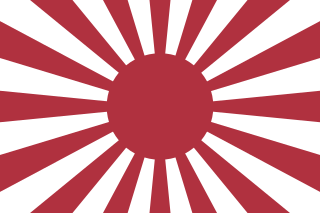
The Imperial Japanese Army (IJA) was the principal ground force of the Empire of Japan. Forming one of the military branches of the Imperial Japanese Armed Forces (IJAF), it was controlled by the Imperial Japanese Army General Staff Office and the Army Ministry, both of which were nominally subordinate to the Emperor of Japan, the supreme commander of IJAF. During the 20th century, an Inspectorate General of Aviation became the third agency with oversight of the IJA. At its height, the IJA was one of the most influential factions in the politics of Japan.

The Czechoslovak Legion were volunteer armed forces consisting predominantly of Czechs and Slovaks fighting on the side of the Entente powers during World War I and the White Army during the Russian Civil War until November 1919. Their goal was to win the support of the Allied Powers for the independence of Lands of the Bohemian Crown from the Austrian Empire and of Slovak territories from the Kingdom of Hungary, which were then part of the Austro-Hungarian Empire. With the help of émigré intellectuals and politicians such as the Czech Tomáš Garrigue Masaryk and the Slovak Milan Rastislav Štefánik, they grew into a force over 100,000 strong.

The Battle of Makin was an engagement of the Pacific campaign of World War II, fought from 20 to 24 November 1943 on Makin Atoll in the Gilbert Islands.
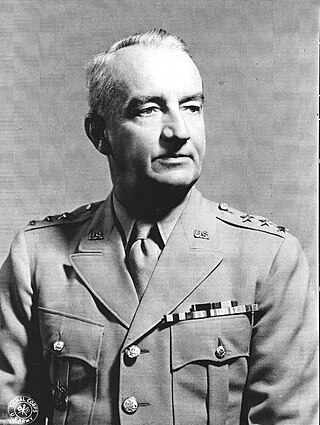
Robert Lawrence Eichelberger was a general officer in the United States Army who commanded the Eighth United States Army in the Southwest Pacific Area during World War II.

The American Expeditionary Force, North Russia was a contingent of about 5,000 United States Army troops that landed in Arkhangelsk, Russia as part of the Allied intervention in the Russian Civil War. It fought the Red Army in the surrounding region during the period of September 1918 through to July 1919.

The Allied intervention in the Russian Civil War consisted of a series of multi-national military expeditions that began in 1918. The initial impetus behind the interventions was to secure munitions and supply depots from falling into the German Empire's hands, particularly after the Bolsheviks signed the Treaty of Brest-Litovsk, and to rescue the Allied forces that had become trapped within Russia after the 1917 October Revolution. After the Armistice of 11 November 1918, the Allied plan changed to helping the White forces in the Russian Civil War. After the Whites collapsed, the Allies withdrew their forces from Russia by 1925.

Saburō Kurusu was a Japanese career diplomat. He is remembered now as an envoy who tried to negotiate peace and understanding with the United States while the Japanese government under Emperor Shōwa was secretly preparing the attack on Pearl Harbor.

The American Expeditionary Force, Siberia was a formation of the United States Army involved in the Russian Civil War in Vladivostok, Russia, after the October Revolution, from 1918 to 1920. The force was part of the larger Allied North Russia intervention. As a result of this expedition, early relations between the United States and the Soviet Union were poor.
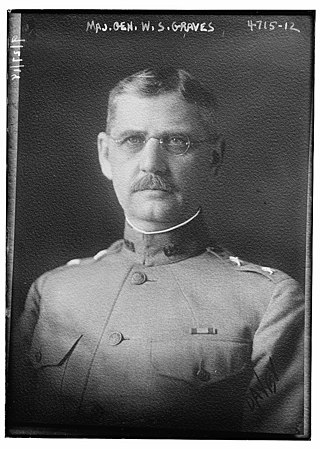
Major General William Sidney Graves was a United States Army officer who commanded American forces in Siberia during the Siberian Expedition, part of the Allied Intervention in Russia, towards the end of World War I.
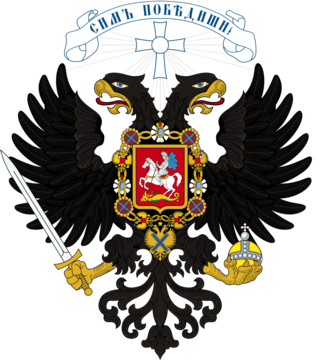
The White Army or White Guard, also referred to as the Whites or White Guardsmen, was a common collective name for the armed formations of the White movement and anti-Bolshevik governments during the Russian Civil War. They fought against the Red Army of Soviet Russia.
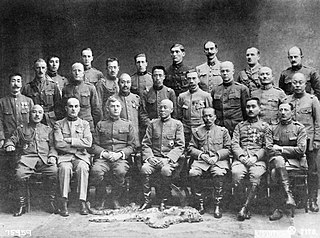
The Siberian intervention or Siberian expedition of 1918–1922 was the dispatch of troops of the Entente powers to the Russian Maritime Provinces as part of a larger effort by the western powers, Japan, and China to support White Russian forces and the Czechoslovak Legion against Soviet Russia and its allies during the Russian Civil War. The Imperial Japanese Army continued to occupy Siberia even after other Allied forces withdrew in 1920.
The 27th Infantry Regiment, nicknamed the "Wolfhounds", is an infantry regiment of the United States Army established in 1901, traditionally aligned with the 25th Infantry Division for more than 8 decades. It served in the Philippine–American War, in the Siberian Intervention after World War I, and as part of the 25th Infantry Division during World War II, the Korean War, the Vietnam War, and later, the Iraq War.

SMS Fürst Bismarck was Germany's first armored cruiser, built for the Kaiserliche Marine before the turn of the 20th century. The ship was named for the German statesman Otto von Bismarck. The design for Fürst Bismarck was an improvement over the previous Victoria Louise-class protected cruisers—Fürst Bismarck was significantly larger and better armed than her predecessors.

Lionel Colin Matthews, was an Australian Army officer in World War II. He was posthumously awarded the George Cross, the highest award for extraordinary acts of gallantry away from the field of battle that could be awarded to a member of the Australian armed forces at the time. Matthews was born in Adelaide, South Australia, and was schooled there before moving to Victoria. He trained as a signalman in the Royal Australian Naval Reserve before joining the Militia in April 1939. Commissioned as an officer in the Australian Corps of Signals, Matthews transferred to the 8th Division of the Second Australian Imperial Force after the outbreak of World War II.

The Canadian Siberian Expeditionary Force (French: Corps expéditionnaire sibérien) (also referred to as the Canadian Expeditionary Force (Siberia) or simply the C.S.E.F.) was a Canadian military force sent to Vladivostok, Russia, during the Russian Revolution to bolster the allied presence, oppose the Bolshevik Revolution and attempt to keep Russia in the fight against Germany. Composed of 4,192 soldiers and authorized in August 1918, the force returned to Canada between April and June 1919. The force was commanded by Major General James H. Elmsley. During this time, the C.S.E.F. saw little fighting, with fewer than 100 troops proceeding "up country" to Omsk, to serve as administrative staff for 1,500 British troops aiding the anti-Bolshevik White Russian government of Admiral Alexander Kolchak. Most Canadians remained in Vladivostok, undertaking routine drill and policing duties in the volatile port city.

The Japanese Siberian Intervention of 1918–1922 was a dispatch of Japanese military forces to the Russian Maritime Provinces, as part of a larger effort by western powers and Japan to support White Russian forces against the Bolshevik Red Army during the Russian Civil War. The Japanese suffered 1,399 killed and another 1,717 deaths from disease. Japanese military forces occupied Russian cities and towns in the province of Primorsky Krai between 1918 and 1922.

The Siberian Army was an anti-Bolshevik army during the Russian Civil War, which fought from June 1918 – July 1919 in Siberia – Ural Region.
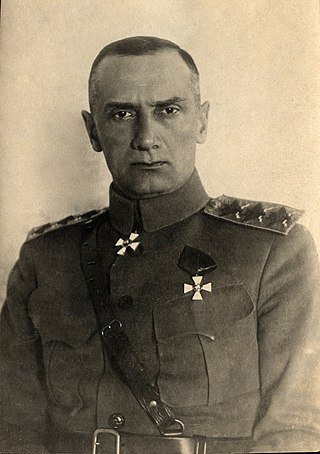
Admiral Alexander Vasilyevich Kolchak was a Russian navy officer and polar explorer who led the White movement in the Russian Civil War. As he assumed the title of Supreme Ruler of Russia in 1918, he headed a military dictatorship, which ruled over the territory of the former Russian Empire controlled by the Whites. He was a proponent of Russian nationalism and militarism, while he opposed democracy as a principle which he believed to be tied to pacifism, internationalism and socialism. As the principal leader of the White movement, he was one of the key architects of the White Terror.

Major-General James Harold Elmsley, was a Canadian military officer who served with the Royal Canadian Dragoons in the Canadian Expeditionary Force during the First World War. Later in the war, he would command the 8th Canadian Infantry Brigade, as well as the Canadian Siberian Expeditionary Force during the Allied intervention in the Russian Civil War.

Ivan Pavlovich Kalmykov, was an Ataman of the Ussuri Cossacks and General associated with the Anti-Bolshevik White Movement during the Russian Civil War.
